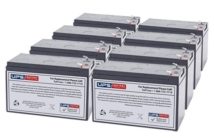The abbreviated “SI units” come from the French translation of Système International d’Unités. An international conference is held every two years to update the list of units. This conference is attended by representatives from various industrial countries and organizations from both engineering and scientific fields.
All the SI units relevant to batteries, like the other units as well, are under the maintenance of the International Bureau of Weights and Measures (BIPM, Bureau International des Poids et Mesures) in Paris.

The official list of SI units for batteries, as of the date of this article, are as follows: (in alphabetical order)
Ampere (A or amp). This is considered as the SI base unit of electric current. It was named after André-Marie Ampère, the French physicist who discovered the formula to compute it. This measurement refers to the amount of constant current (electric charge) that produces a force equal to 2×10-7 newton per meter on two straight parallel conductors.
Ampere hour (Ah or amp hr). This is a unit of electric charge that is used to define the capacity of batteries. A steady flow of 1 ampere for 1 hour (straight) is 1 Ah. The equivalent is 3600 coulomb.
Coulomb (C). This is an SI derived unit of an electric charge. The amount of charge that is accumulated per second of a 1 amp current is measured as 1 coulomb (C). This measurement was named after Charles-Augustin de Coulomb, another French physicist.
Farad (F). This is another SI derived unit that measures electric capacity. It was named after Michael Faraday, a British physicist. When a pair of conductors are separated by an insulator, they can store more charge as compared to an isolated conductor. The quality of the insulator will determine the amount of charge that the conductors can carry. This particular circuit property is known as capacitance. One farad is the ability of the conductor to store 1 C (coulomb) of charge for every volt of potential difference between the two conductors. In some practical circuits, the measurement of capacitance is done through nanofarads or microfarads.
Faraday (Fd). This measurement refers to a unit of electric charge. This was also credited to Michael Faraday. He determined that there is a constant charge that is needed to deposit 1 mole of any element. This charge is called Faraday’s constant and is equivalent to 96 485 coulombs. It was adapted later on as a unit of measurement for charges used in electrolysis. 1 Fd is equivalent to the product of a charge on a single electron and Avogadro’s constant.
Henry (H). This is an SI unit that measures electric inductance. To be specific, this unit measures the electric current that is induced into a conductor located within a changing magnetic field. The amount of current will depend on the coil (measured in henry) and the rate of the magnetic flux changes (measured in webers per second). That means that a coil that has an inductance of 1 H usually requires a flux of 1 weber per ampere of the current induced. This unit of measurement was named after Joseph Henry, an American physicist.
Hertz (Hz). This is an SI unit of frequency that is equivalent to one cycle per second. It is the measurement of the rates of event that usually happen periodically within a fixed cycle. This unit of measurement is named after Heinrich Rudolf Hertz, a German physicist.
Joule (J). This is an SI unit of energy. Although energy comes in various forms (electrical, kinetic, electromagnetic, etc), they usually end up using the same unit of measurement – joule. Basically, a joule is the amount of energy exerted as the force of 1 newton is applied over a displacement of 1 meter. 1 joule is also equal to the energy of 1 watt per second. This measurement was named after James Prescott Joule, a British physicist.
Ohm (Ω). This is an SI unit that measures electrical resistance. When two locations that have varying electrical potentials are connected through a conductor, a current flows through that conductor. The current that goes through the conductor will depend on the potential difference and the resistance to the flow of current. One ohm is the amount of resistance that needs a potential difference of 1 volt per ampere. This unit of measurement was named after Georg Simon Ohm, a German physicist.
Siemens (S). This is an SI derived unit of electric conductance. One siemens is when a conductor carries a current of one ampere per volt of potential. The conductance is the inverse of resistance – that means the siemens is the reciprocal of the ohm. This measurement was named after Werner von Siemens, a German inventor and industrialist.
Volt (V). This is an SI derived unit of electrical potential. An electrical potential refers to the amount of potential energy that is present per unit of charge. A volt represents a potential of one joule per coulomb of charge.

Watt (W). This is an SI derived unit of power. It is the rate by which energy is spent. A watt is equivalent to one joule per second. This unit of measurement is used in both electricity and mechanics. It is named after James Watt, a British engineer.
Watt hour (Wh). This refers to a unit of energy that represents the delivered energy at the rate of one watt for one hour. This equals to 3.6 kilojoule (kJ) of energy.
Related Articles:
What Is An Ampere Hour Rating (Amp Hour or Ah) Of A Battery?



